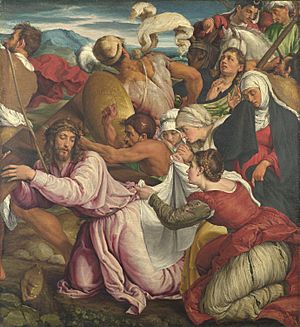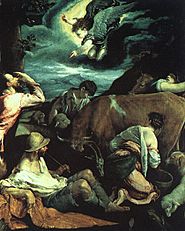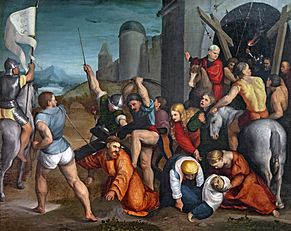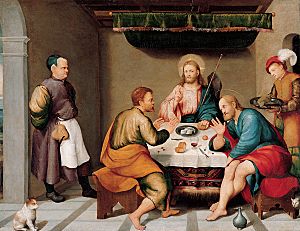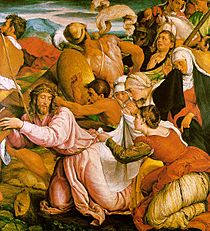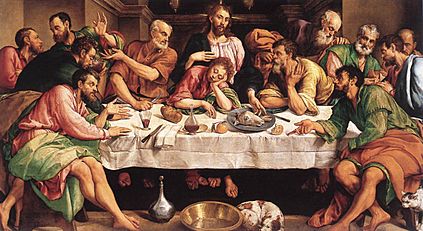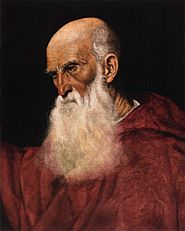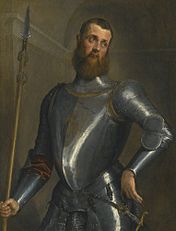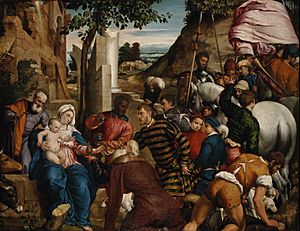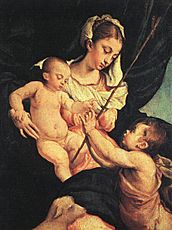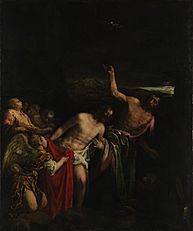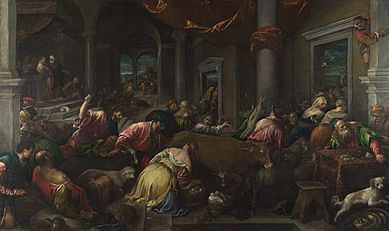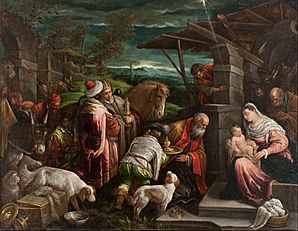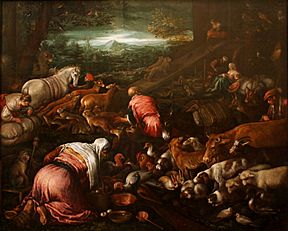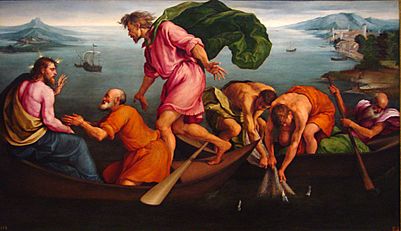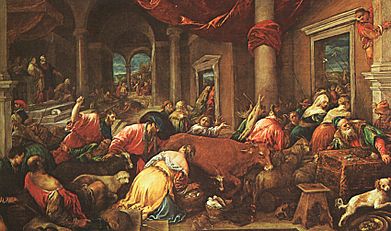Jacopo Bassano facts for kids
Quick facts for kids
Jacopo Bassano
|
|
|---|---|

Self-portrait in later age
|
|
| Born |
Jacopo dal Ponte
c. 1510 Bassano del Grappa near Venice, Republic of Venice
|
| Died | 14 February 1592 (aged 81–82) Bassano del Grappa near Venice, Republic of Venice
|
| Nationality | Italian |
| Education | Bonifazio Veronese |
| Known for | Painting |
|
Notable work
|
The Supper at Emmaus (1538) Flight into Egypt (1544) Christ in the House of Mary and Martha Baptism of Christ (1590) |
| Movement | Venetian School |
Jacopo Bassano (born around 1510 – died 1592) was a famous Italian painter. He was also known as Jacopo dal Ponte. He was born and died in a town called Bassano del Grappa, near Venice. He even took the town's name as his own last name!
Jacopo learned painting from his father, Francesco the Elder. He also studied with Bonifazio Veronese in Venice. Jacopo mostly painted religious scenes. But he often added landscapes and everyday life, called genre scenes, to his art.
He liked to show Bible stories as if they were happening in the countryside. His paintings often featured local farmers and animals, which he drew with great care. People in Venice loved his art, especially his animal pictures and scenes painted at night.
Jacopo had four sons who also became artists: Francesco Bassano the Younger, Giovanni Battista da Ponte, Leandro Bassano, and Girolamo da Ponte. They all painted in a style very similar to their father's.
Contents
Jacopo Bassano's Life Story

Jacopo Bassano was born around 1510. His hometown, Bassano del Grappa, is about 65 kilometers from the big city of Venice. His father, Francesco il Vecchio, was a successful painter in their town. He had a family workshop where they mostly created religious artworks.
When Jacopo was young, he worked as an apprentice in his father's workshop. This means he learned painting by helping his father. In the 1530s, he moved to Venice. There, he studied with Bonifazio de Pitati, also known as Bonifazio Veronese. He also saw the works of famous artists like Titian and il Pordenone.
After his father passed away in 1539, Jacopo went back to Bassano del Grappa. He stayed there for good. In 1546, he married a local woman named Elisabetta Merzari. He took over the family workshop. Later, his four sons – Leandro Bassano, Francesco Bassano the Younger, Giovanni Battista da Ponte, and Girolamo da Ponte – joined him.
Jacopo Bassano died in 1592. His sons kept painting in his style. Because of this, it can be hard for art experts today to tell which paintings were made by Jacopo himself and which were made by his sons.
Jacopo Bassano was special among artists of his time. He could use ideas from many different artists in his work. These included Dürer, Parmigianino, Tintoretto, and Raphael. He did this even though he rarely left his hometown. People believe he learned about their art by looking at their prints, which he probably collected.
Jacopo Bassano's Artworks
Jacopo Bassano was always trying new things and learning from other artists. You can see this in the four different periods of his art. Each period shows how he combined his own ideas with the styles of other painters.
Early Paintings: The 1530s
Bonifazio de Pitati taught Jacopo to appreciate the work of Titian. You can clearly see Titian's influence in Jacopo's early paintings. Jacopo's first works show his love for bright, glowing colors. He got this idea from Titian's early art.
A great example is Bassano's Supper at Emmaus (1538). He painted this for a local church. In this painting, Jacopo fills the canvas with rich, bright colors. These colors help the people in the painting stand out. He also did something different from other artists. He placed Jesus towards the back of the scene. This allowed the everyday people around Jesus to be a more important part of the painting.
The people in his paintings also wore unique clothes. Instead of the loose, shapeless clothes that many Renaissance artists used, Bassano dressed his figures in 16th-century clothing. The small details in this painting are often talked about. He included different foods on the tables, a dog lying down, and a cat sneaking around the chairs. He also added many other people in the background. This shows that Bassano liked to paint what he saw in real life. He didn't just follow the usual art rules of his time.
Mannerism in Bassano's Art
Bassano's painting, The Last Supper (1542), shows his new interest in Mannerism. Mannerism was a style of art in Italy. In this painting, you can see ideas from prints by Dürer and paintings by Raphael. This is clear in the strong feelings shown by the people and their active, stylish poses.
Mannerist artists loved detailed designs. Bassano showed this by carefully placing his figures. He gave them strong "characters" to create a lively painting. This makes your eyes move around every part of the canvas. Compared to his earlier paintings, where people looked calm, the figures in The Last Supper seem full of life. Their skin looks like it has muscles and bones underneath, not like the stiff figures from his earlier work.
Around the 1550s to 1570s, Bassano started to experiment with light and his subjects. During this time, he was one of the first artists to paint a "nocturne." This is a painting of a nighttime scene with artificial light. These types of paintings were very popular with people in his area. They made Bassano's paintings highly valued.
His artworks also began to feature more elements from country life. His father had painted these, and they were part of Jacopo's own surroundings. Instead of placing religious scenes in old Roman settings, he put figures in more natural landscapes. The trees and flowers in these paintings were drawn just as carefully as the people.
- Paintings
-
The Annunciation to the Shepherds (1533), Belvoir Castle
-
The Procession to Calvary (1540), The National Gallery
-
Madonna and Child with St John the Baptist (1570), Galleria degli Uffizi
-
The Purification of the Temple, The National Gallery
See also
 In Spanish: Jacopo Bassano para niños
In Spanish: Jacopo Bassano para niños



